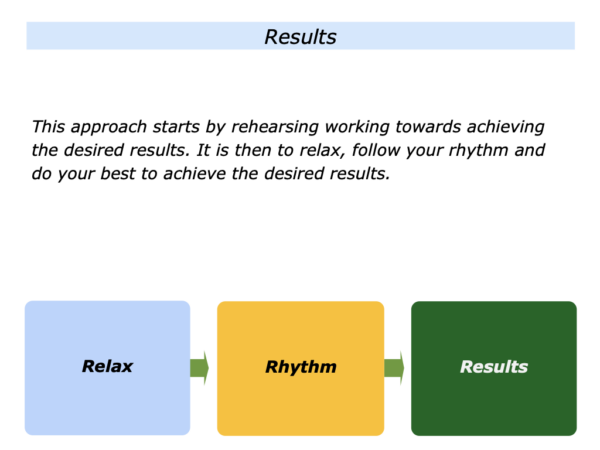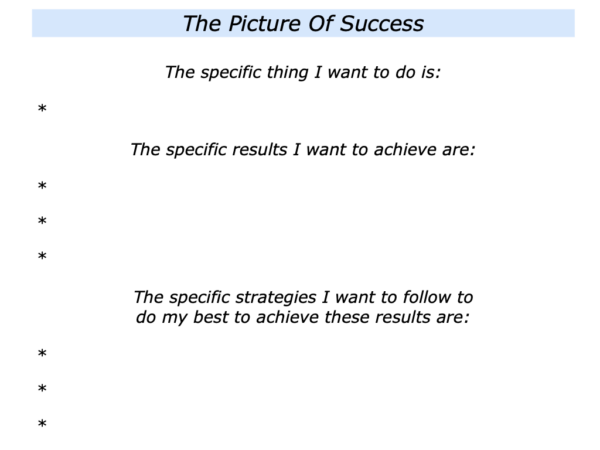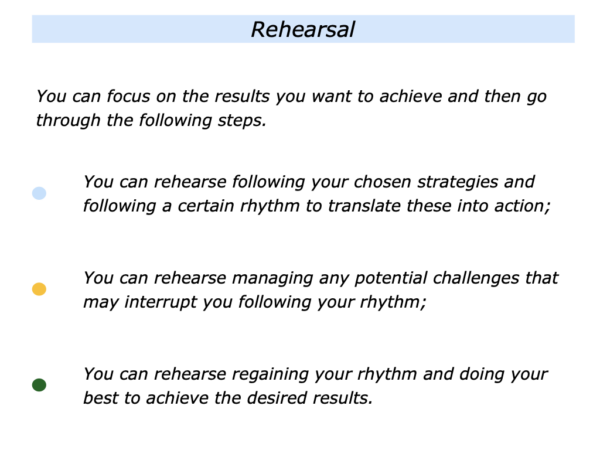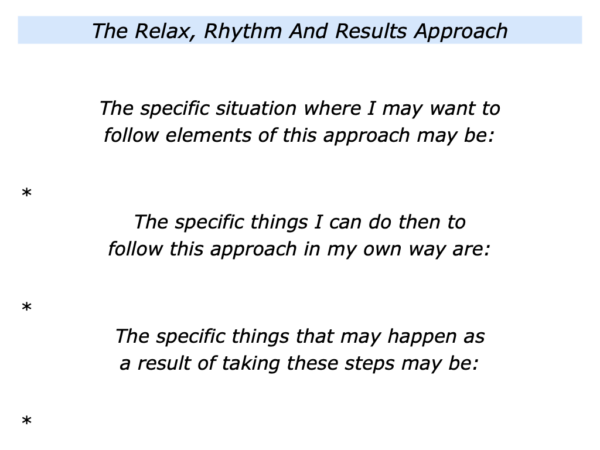
There are many ways to do fine work. One approach to start by rehearsing working towards achieving the desired results. It is then to relax, follow your rhythm and do your best to achieve the desired results.
Imagine you want to follow this approach in your own way. Let’s explore how to translate it into action.
Rehearsing Working Towards
Achieving The Desired Results
The first step is to think of a situation where you may want to achieve a specific goal. Here are some things that people mention when exploring this theme.
“I want to do a great piece of work … I want to run a workshop that helps people to shape their futures … I want to give an inspiring performance at a concert … I want do my best in a sporting event … I want to help my team to achieve success.”
Results
Imagine that you have chosen to work towards a goal. Bearing in mind what you can control in the situation, you can explore the following steps.
What are the real results I want to achieve? What is the picture of success? What are the strategies I can follow to give myself the greatest chance of success? How can I translate these into a clear action plan?
How can I translate these steps into following a certain rhythm? How can I relax yet still be alert and follow this rhythm? How can I manage interruptions and regain my rhythm? How can I do my best to achieve the results?
Let’s assume you have explored these themes. If appropriate, you can summarise these in the following way.

Imagine that you have clarified your plan. You may then move on to the next stage.
Rehearsal
Great workers often rehearse what they are going to do next. Sometimes they spend a long time taking this step. Sometimes they take a short time – especially when they need to make quick decisions.
Imagine that you are going to take this step. You will, of course, do this in your own way. If appropriate, however, one approach is to work through the following stages.

Imagine you are clear on: a) the specific results to achieve; b) the specific strategies you want to follow; c) the specific things you can to do follow your chosen rhythm.
You are now ready to move into action. One approach is to focus on the following themes.
Relax
Great workers often rest, rehearse and follow a ritual before clicking into action. They then aim to be relaxed yet also stay alert when following their plan to achieve the goals.
Different people do this in different ways. A footballer may breathe deeply before taking a penalty kick. An actor may pause, recentre and visualise what they are going to do before going on stage.
Some people aim to go into a state of flow. Bearing in mind the goal they want to achieve, they aim to flow, focus and do fine work. They may then do their best to finish properly and, as a by-product, find fulfilment.
Let’s return to your situation. How can you relax before setting out on the journey? How can you then continue to be relaxed yet also stay alert? How can you be fully present and aim to do positive work?
Imagine that you are able to be relaxed yet fully alert. Moving into action, you may then focus on the following theme.
Rhythm
Great workers follow their chosen rhythm when doing their work. They aim to keep following good habits on the way towards achieving their goals. Different people do this in different ways.
Some focus on their chosen strategies and the steps they can take to translate these into action;
Some focus on delivering consistently high professional standards and translating these into action;
Some focus on a personal mantra they want to follow – such as ‘Be positive and professional’ – and translate this into action.
Reading Reality
Great workers follow their rhythm but also keep reading reality. They keep scanning the situation to see what is happening and what could happen. They focus on:
The specific things that are going well and how to build on these things;
The specific things that could be done better and how to improve these things;
The specific things that could happen in the future and how to deal with these situations.
Great workers are good at seeing both positive and negative patterns. They build on the positive patterns and manage the consequences of any negative patterns. This helps them to do their best to shape the future.
Let’s assume you are following some of these themes. You may then focus on the next stage.
Results
Great workers do their best to achieve the desired results. They keep performing superb work, encouraging themselves and focusing on continuous improvement.
Sometimes this calls for them buying time to think when faced by challenges. It also involves them being able to demonstrate the following quality.
Revitalisation
Great workers often have a history of revitalising themselves after both successes and setbacks. Some do this by exploring the following themes.
Successes
What are the successes I have had? What did I do right to achieve these successes? What were the principles I followed? How can I follow these principles – plus add other skills – to succeed in the future?
Setbacks
What can I learn from the setback I have had? What can I do better to prevent or manage such things happening in the future? What can I do to build on these lessons and increase the chances of success?
Such people apply these lessons to revitalise themselves. They then do their best to achieve success.
Regaining Your Rhythm
Great workers aim to make things as predictable as possible. Sometimes they are able to follow their rhythm, make things routine and achieve the desired results.
Sometimes they may encounter random or unpredictable events that can throw them off-course. Buying time to think, they then clarify what is happening and take the following approach.
They clarify how to deal with any immediate challenges, take the necessary action and they then clarify the future picture of success;
They clarify the possible ways forward – together with the pluses and minuses of each option – and settle on their strategy for working towards the picture of success;
They clarify how to follow their chosen strategy, regain their rhythm and do their best to achieve the picture of success.
Great workers then take action to do something to get a quick win. Building on this success, they then aim to follow their rhythm on the way towards achieving their goals.
Results
Let’s return to your situation. Bearing in mind what you can control, how can you do your best to deliver the desired results? One approach is to follow your successful pattern for finishing.
Imagine that you are aiming to achieve a specific goal. What is your positive history for tackling such challenges? Looking back, when have you worked successfully to achieve a similar goal?
What did you do right then? What where the principles you followed to finish successfully? How did you translate these into action? How can you follow similar principles to work towards achieving your present goal?
Imagine that you have found some elements of your successful pattern. If appropriate, you can follow these – plus maybe add other skills – to do your best to achieve the desired results.
As mentioned earlier, some people aim to follow such principles by going into a state of flow. They aim to flow, focus and do fine work. They then aim to finish and, as a by-product, sometimes find fulfilment.
Let’s return to your own life and work. Looking ahead, can you think of a situation where you may want to follow elements of the relax, rhythm and results approach?
How can you clarify the desired results? How can you rehearse following your chosen strategy? Moving into action, how can you relax and yet be alert? How can you follow your chosen rhythm? How can you do your best to achieve the desired results?
If you wish, try tackling the exercise on this theme. This invites you to complete the following sentences.



Leave a Reply